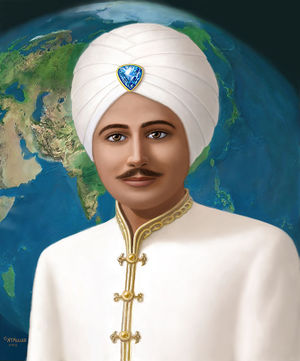Chananda

Chananda is the chief of the Indian Council of the Great White Brotherhood. His sister is the ascended lady master Najah.
Encarnaciones
Chananda fue un erudito de Mu y vivió en la ciudad de las siete colinas, donde hoy se encuentra San Francisco.
Estuvo encarnado en la época de Jesús y conoció al Maestro de Judea. Vio su radiante magnetismo y «percibió la Presencia de la inmortalidad brillando a través de su vestidura exterior»Cite error: Invalid <ref> tag; refs with no name must have content.
Su servicio hoy
A ciertos chelas no ascendidos Chananda ha demostrado los extraordinarios poderes que tienen a su disposición todas las huestes ascendidas. En una ocasión se elevó en el aire haciendo lo mismo con Godfre, Rex y Nada, Bob y Pearl (entonces no ascendidos) en una «alfombra mágica» (una plancha de metal cubierta con una alfombra persa) a 1100 pies de altura para disfrutar del panorama de un valle.Cite error: Invalid <ref> tag; refs with no name must have content
Chananda apareció en 1937 para ayudar a Saint Germain a implementar su plan para la libertad de la Tierra, al igual que hizo Najah en 1938. Él presta ayuda a los gobiernos del mundo, mientras que ella trabaja con la juventud, con frecuencia apareciéndose como una joven muchacha en partes de la India y China, enseñando y ayudando a la gente.
Chananda is currently working on a top-priority project with the Darjeeling Council and unascended initiates of the Brotherhood. Part of this project involves the precipitation of a golden-age government based on the principles behind the Constitution of the United States. This God-inspired document was released to America by its founder, the ascended master Saint Germain; and when properly used and followed, it will provide the key to a golden-age civilization that is just beyond the horizon.
Chananda is particularly concerned with the problems of racial and religious divisions between people and with the future of India. He outlines the path of peace as the way of overcoming:
India was won through nonviolence. We shun violence and exude the peace of the Buddha, which is the all-power of God. But we would have our chelas understand that when you depend upon the peace of the Buddha as the ultimate power, then it would be well for you to study assiduously the terms of that peace. For you must make peace with your God if you expect your God to provide that power in the hour when peace is challenged by absolute war....
I know whereof I speak. I remember in a previous incarnation as the battle raged all around me and I stood holding the balance in the midst of thousands and ten thousand. Blessed hearts, I stood in their midst holding the focus of the sacred fire. And do you know—they saw me not! I was not visible in the physical spectrum, though I was in physical embodiment. And thereby...by my unswerving allegiance to the light, which I owe to the Almighty and to him alone—I was that pillar! I was that fire! And thus they could not continue the battle. And they retreated on both sides, leaving me standing alone in the midst of the plain of the battle itself.[1]
Call to beloved Chananda, the Great Divine Director, El Morya and Saint Germain for the proper implementation of the plans for God-government throughout the world.
Retreats
► Main article: Cave of Light
► Main article: Palace of Light
Chananda is hierarch of the Cave of Light, the focus of the Great Divine Director in India. The Palace of Light, which is adjacent to the Cave of Light, is the home of Chananda and Najah.
See also
Indian Council of the Great White Brotherhood
Sources
Mark L. Prophet and Elizabeth Clare Prophet, The Masters and Their Retreats, s.v. “Chananda.”
- ↑ Chananda, “India in Her Darkest Hour,” Pearls of Wisdom, vol. 24, no. 23, June 7, 1981.
